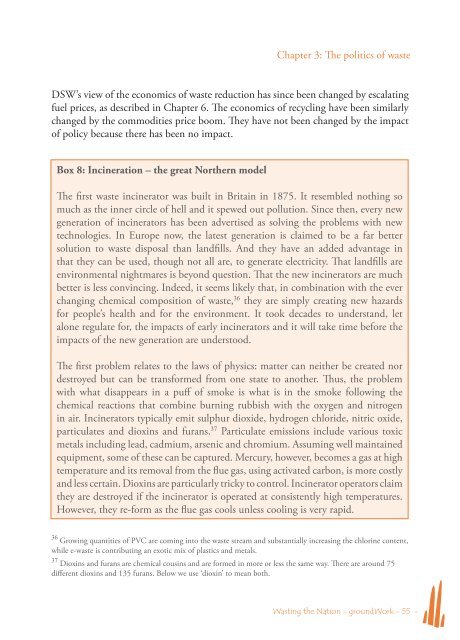Wasting the Nation.indd - Groundwork
Wasting the Nation.indd - Groundwork
Wasting the Nation.indd - Groundwork
Create successful ePaper yourself
Turn your PDF publications into a flip-book with our unique Google optimized e-Paper software.
Chapter 3: The politics of wasteDSW’s view of <strong>the</strong> economics of waste reduction has since been changed by escalatingfuel prices, as described in Chapter 6. The economics of recycling have been similarlychanged by <strong>the</strong> commodities price boom. They have not been changed by <strong>the</strong> impactof policy because <strong>the</strong>re has been no impact.Box 8: Incineration – <strong>the</strong> great Nor<strong>the</strong>rn modelThe first waste incinerator was built in Britain in 1875. It resembled nothing somuch as <strong>the</strong> inner circle of hell and it spewed out pollution. Since <strong>the</strong>n, every newgeneration of incinerators has been advertised as solving <strong>the</strong> problems with newtechnologies. In Europe now, <strong>the</strong> latest generation is claimed to be a far bettersolution to waste disposal than landfills. And <strong>the</strong>y have an added advantage inthat <strong>the</strong>y can be used, though not all are, to generate electricity. That landfills areenvironmental nightmares is beyond question. That <strong>the</strong> new incinerators are muchbetter is less convincing. Indeed, it seems likely that, in combination with <strong>the</strong> everchanging chemical composition of waste, 36 <strong>the</strong>y are simply creating new hazardsfor people’s health and for <strong>the</strong> environment. It took decades to understand, letalone regulate for, <strong>the</strong> impacts of early incinerators and it will take time before <strong>the</strong>impacts of <strong>the</strong> new generation are understood.The first problem relates to <strong>the</strong> laws of physics: matter can nei<strong>the</strong>r be created nordestroyed but can be transformed from one state to ano<strong>the</strong>r. Thus, <strong>the</strong> problemwith what disappears in a puff of smoke is what is in <strong>the</strong> smoke following <strong>the</strong>chemical reactions that combine burning rubbish with <strong>the</strong> oxygen and nitrogenin air. Incinerators typically emit sulphur dioxide, hydrogen chloride, nitric oxide,particulates and dioxins and furans. 37 Particulate emissions include various toxicmetals including lead, cadmium, arsenic and chromium. Assuming well maintainedequipment, some of <strong>the</strong>se can be captured. Mercury, however, becomes a gas at hightemperature and its removal from <strong>the</strong> flue gas, using activated carbon, is more costlyand less certain. Dioxins are particularly tricky to control. Incinerator operators claim<strong>the</strong>y are destroyed if <strong>the</strong> incinerator is operated at consistently high temperatures.However, <strong>the</strong>y re-form as <strong>the</strong> flue gas cools unless cooling is very rapid.36 Growing quantities of PVC are coming into <strong>the</strong> waste stream and substantially increasing <strong>the</strong> chlorine content,while e-waste is contributing an exotic mix of plastics and metals.37 Dioxins and furans are chemical cousins and are formed in more or less <strong>the</strong> same way. There are around 75different dioxins and 135 furans. Below we use ‘dioxin’ to mean both.<strong>Wasting</strong> <strong>the</strong> <strong>Nation</strong> - groundWork - 55 -
















